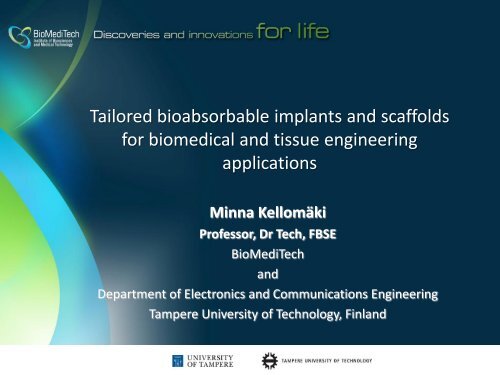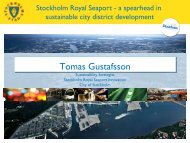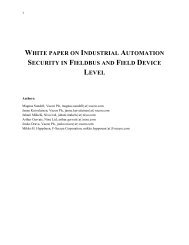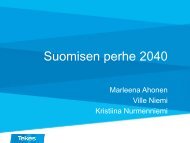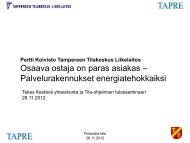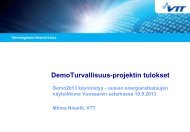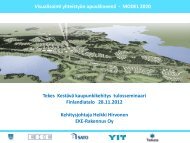Tampere University of Technology - Tekes
Tampere University of Technology - Tekes
Tampere University of Technology - Tekes
You also want an ePaper? Increase the reach of your titles
YUMPU automatically turns print PDFs into web optimized ePapers that Google loves.
Tailored bioabsorbable implants and scaffolds<br />
for biomedical and tissue engineering<br />
applications<br />
Minna Kellomäki<br />
Pr<strong>of</strong>essor, Dr Tech, FBSE<br />
BioMediTech<br />
and<br />
Department <strong>of</strong> Electronics and Communications Engineering<br />
<strong>Tampere</strong> <strong>University</strong> <strong>of</strong> <strong>Technology</strong>, Finland
<strong>Tekes</strong> review 289/2012, p. 63<br />
History <strong>of</strong> biomaterials research in Finland
4.9.2013<br />
1 st in the world innovations and products<br />
• 1st in the world several surgical implant families<br />
introduced to clinical studies, examples:<br />
• Ultra-high strength pins and screws for bone<br />
fracture fixation<br />
• Membranes for guided tissue regeneration<br />
• Arrows for closing <strong>of</strong> knee meniscus ruptures<br />
• Stents for urological and gastro-enterological<br />
applications<br />
• Malleable plates for craniomaxill<strong>of</strong>acial, spine<br />
and thoracic surgical applications<br />
• Antibiotic releasing screws for prophylactic<br />
applications<br />
• Bioreconstructive scaffolds for finger and toe<br />
joint regeneration<br />
3
Biomaterials research areas<br />
Leader: Minna Kellomäki Pr<strong>of</strong>, Dr Tech, FBSE<br />
• Processing, microstructures and properties <strong>of</strong>:<br />
• Bioabsorbable, synthetic polymers<br />
• Hydrogels<br />
• Modified natural organic materials<br />
• Polymer-ceramic composites<br />
• Bioceramics and bioactive glasses<br />
• Development <strong>of</strong>:<br />
• Surgical implants and implantable measuring devices<br />
• Scaffolds for tissue engineering<br />
• Drug releasing biomaterials<br />
• Biocompatible surfaces and electrical properties <strong>of</strong><br />
biomaterials
Advanced Tissue Regeneration <strong>Technology</strong>;<br />
Osteopromotive Composite Scaffolds and Cellular<br />
Response with Human Adipose Stem Cells<br />
“KURKO”
Requirements for TE-scaffold technology<br />
Requirements for a tissue<br />
engineering scaffold:<br />
• Biocompatible<br />
• Optimal pore size<br />
• Interconnected pore<br />
structure<br />
• Bioabsorbable<br />
Requirements for a technology<br />
transfer from the lab to the clinics:<br />
• Better functionality or activity<br />
compared to the existing<br />
technology<br />
• High manufacturing rate and<br />
yield<br />
• Low manufacturing costs<br />
• Easy to use
Scaffold structures<br />
• PLCL:<br />
• Porosity up to 70 %<br />
• Average pore size 500-1000 µm<br />
• Max pore size 1300-2300 µm<br />
• PLCL-β-TCP 40 wt-%:<br />
• Porosity up to 70 %<br />
• Average pore size 300-800 µm<br />
• Max pore size 600-2300 µm<br />
Scaffold + water<br />
• PLCL-β-TCP 60 wt-%:<br />
• Porosity up to 60 %<br />
• Average pore size 300-600 µm<br />
• Max pore size 600-1500 µm<br />
Scaffold phase<br />
Water phase<br />
Pore interconnectivity 98-99 %
In vitro cytocompatibility<br />
• Seeding with human<br />
adipose stem cells<br />
(660 cells/ mm 3 )<br />
• Cell attachment and<br />
viability<br />
• Live/dead-fluorescent probes<br />
• Cell proliferation<br />
• Quantitative DNA analysis<br />
(CyQuant)<br />
• Early stage osteogenic<br />
differentiation<br />
• Quantitative alkaline<br />
phosphatase activity<br />
• Adipose stem cells have<br />
been used successfully for<br />
clinical bone regeneration<br />
[2,3]<br />
[2] Mesimaki K, et al. Int J Oral Maxill<strong>of</strong>ac Surg, 2009.<br />
[3] Thesleff T, et al. Neurosurgery, 2011.
Conclusions<br />
• ScCO 2 -processing enables effective manufacturing <strong>of</strong><br />
porous and biodegradable scaffolds without harmful<br />
solvents<br />
• The scaffolds mechanical properties enable cyclic loading<br />
and easy tailoring <strong>of</strong> the scaffolds to the desired shape<br />
• PLCL 70/30 – β-TCP scaffolds support the attachment<br />
and stimulate the proliferation <strong>of</strong> hASCs<br />
• Preliminary results show also that the<br />
scaffolds induce the early osteogenic<br />
differentiation
The Team and Acknowledgements<br />
Scientific team:<br />
<strong>Tampere</strong> <strong>University</strong> <strong>of</strong> <strong>Technology</strong><br />
Pr<strong>of</strong>essor Minna Kellomäki<br />
Kaarlo Paakinaho<br />
Niina Ahola<br />
Pr<strong>of</strong>essor Mika Valden<br />
Leena Vuori<br />
Pr<strong>of</strong>essor Jari Hyttinen<br />
Markus Hannula<br />
<strong>Tampere</strong> <strong>University</strong><br />
Doc. Susanna Miettinen<br />
Suvi Haimi<br />
Laura Tirkkonen<br />
Sanna Huttunen<br />
Funding and collaboration:<br />
The Finnish Funding Agency for<br />
<strong>Technology</strong> and Innovation<br />
Industrial collaboration:<br />
Aalto <strong>University</strong><br />
Pr<strong>of</strong>essor Jukka Seppälä<br />
Laura Elomaa<br />
International collaboration with:<br />
Pr<strong>of</strong>essor Dirk Grijpma, <strong>University</strong> <strong>of</strong> Twente, The Netherlands<br />
Pr<strong>of</strong>essor Marcy Zenobi-Wong, ETH Zürich, Switzerland<br />
Pr<strong>of</strong>essor Maria Rita Passos-Bueno, <strong>University</strong> <strong>of</strong> Sao Paulo, Brazil
Biomaterials for regenerative<br />
medicine<br />
-<br />
Human Spare Parts project<br />
http://www.biomeditech.fi/research/human_spare_parts_program.php
In the picture 1990’s human spare parts<br />
Scientific teams:<br />
<strong>Tampere</strong> <strong>University</strong> <strong>of</strong> <strong>Technology</strong><br />
Pr<strong>of</strong>essor Minna Kellomäki (Biomaterials)<br />
Pr<strong>of</strong>essor Jari Hyttinen (Imaging and image analysis)<br />
Pt<strong>of</strong>essor Jukka Lekkala (Biosensors and measurements)<br />
Pr<strong>of</strong>essor Pasi Kallio (Biomimetic environments)<br />
<strong>Tampere</strong> <strong>University</strong><br />
Doc. Susanna Miettinen (Adipose stem cells)<br />
Doc. Susanna Narkilahti (Neuro)<br />
Doc. Heli Skottman (Ophthalmology)<br />
Doc. Katriina Aalto-Setälä (Cardiac cells and tissues)<br />
Main funding:<br />
The Finnish Funding Agency for<br />
<strong>Technology</strong> and Innovation<br />
http://www.biomeditech.fi/research/human_<br />
spare_parts_program.php
Biomaterials research themes in HSP<br />
1. Fibers and 2D & 3D textiles<br />
2. Hydrogels and functionalization <strong>of</strong><br />
materials<br />
3. Biodegradable sensors<br />
Application areas:<br />
1. Regenerative medicine<br />
2. Cell culture surfaces and devices<br />
3. Material development and characterization<br />
13<br />
4.9.2013
Melt-spun biodegradable fibers<br />
4.9.2013<br />
Melt processing <strong>of</strong> biodegradable polymers<br />
tools<br />
- Design and manufacturing <strong>of</strong> the equipment and<br />
- Optimization <strong>of</strong> parameters for spinning <strong>of</strong> fibers<br />
Coarse Fine Ultra fine Nano & Hollow fibers<br />
•> 100 µm 100-30 µm 30-1 µm < 1 µm > 60 µm<br />
Slide by Ville Ellä / TUT BME
From fibers different<br />
textile structures<br />
4.9.2013<br />
From fibers<br />
production <strong>of</strong> multiple textile structures<br />
from textiles scaffolds and implants<br />
e.g. Knits Braids Non-wovens Wovens<br />
Slide by Ville Ellä / TUT BME
PLA96 + fibrin hybrids<br />
16<br />
Tschoeke B et al. Tissue Engineering 2009<br />
Koch et al, Biomaterials 2010
Two photon polymerization<br />
4.9.2013<br />
- structures and functionalization<br />
- (additional partner: VTT)<br />
(a) (b) (c)<br />
Neurocages (2PP)<br />
Protein structures: BSA (left) and avidin (right) (2PP)<br />
Designed scaffold; close-up <strong>of</strong> nanostructure; cultured<br />
ASCs(2PP)<br />
Miniaturized 17 trabecular<br />
bone replica (2PP)
Shift <strong>of</strong> Frequency (MHz)<br />
Embedded measuring circuits<br />
- Measuring circuit embedded inside polymer foils<br />
- Distant reader system<br />
- Detection <strong>of</strong> water diffusion into the polymer<br />
structure<br />
- We can use this information to e.g.<br />
- Understand material behavior<br />
more deeply<br />
- Enhance material selection<br />
process for applications<br />
- By improving models how<br />
polymers degrade<br />
(collaboration pr<strong>of</strong> Pan,<br />
Univ Leicester)<br />
0<br />
-0.5<br />
-1<br />
Salpavaara et al, 2012<br />
PCL 2,40 mm<br />
PLCL 2,09 mm<br />
PDMS 2.19 mm<br />
-1.5<br />
0 20 40 60 80
Biomaterial requests in HSP<br />
4.9.2013<br />
‣ Permanent –> temporary<br />
‣ Biostabile – bioabsorbable –> bioactive<br />
‣ Replacement - repair –> tissue engineering<br />
‣ Solid -> porous<br />
‣ Hard/rigid & s<strong>of</strong>t/flexible & hydrogel/gel<br />
‣ 2D & 3D<br />
‣ Macro & micro & nano<br />
‣ Basic research<br />
–> R&D<br />
–> commercialization/products<br />
19


